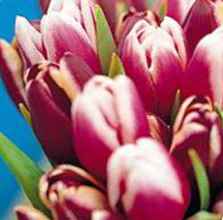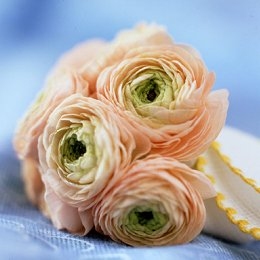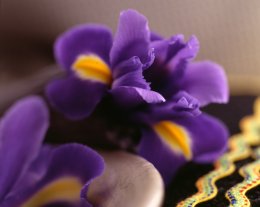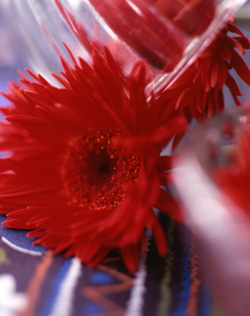 |

|
Fashion Flowers For Spring
The New Collection : Fresh Folklore
|
|
|
<
Tulip
The
third-biggest selling flower in Holland, and are popular in
the UK too.Some of the more exotic forms - such as parrot
(ruched and frilly), fringed (with ice crystal edges), waterlily
(layers of petals) and lily (pointed, curly petals) - look
as if they come from a tropical island.
Their
plain wine-glass shape has a modern simplicity, and tulips
are very popular for spring wedding bouquets as well as home
displays. In their natural season they are very reasonably
priced flowers, and a perfect emblem of spring for many of
us.
> click here for more info on Tulip
|
|
Ranunculus
>
Little
known here in Britain as a cut flower, but are very popular
on the continent. Their botanical name (ran UN kew luss) derives
from the latin for "frog", as the plants like wet
ground. They are sometimes called Persian buttercup - which
refers to their native origins in the Middle East.
They are close relatives of
this common garden weed, but much more decorative! The cup-shaped
flowers are very full - a mass of tissuey petals - on hairy
stems, with very few small ferny leaves. They come in yellow,
like their lawn relatives, and also red, orange, pink, peach,
white and maroon.
> click here for
more info on Ranunculus
|
|
|
|
<
Anenome
Anenomes are becoming
more popular as a cut flower, and their clear colours suit
the spring trend Fresh Folklore very well.
Originally from the
Mediterranean, anemones are now grown across Europe, particularly
Italy, and Israel. They are also related to buttercups, like
ranunculus, but come in jewel colours - ruby, sapphire, amethyst,
diamond white - with jet black hearts. The best cut flower
varieties are "Mona Lisa" forms, which have large
flowers and long, strong stems. Their soft grey-green ferny
leaves make a perfect frame for the flowerheads.
> click here for
more info on Anenome
|
Iris
>
Iris are still symbolic of spring, even
though they are now available all year round. Iris come
in all the colours of the heavens - pure white, baby blue,
sunshine yellow, rich blue and deep navy.
The iris flower is very distinctive; three broad petals
fold back from the stem to form the points of a triangle,
while three smaller petals stand up from the centre. They
form the fleur-de-lys, symbol of the Kings of France. And
if they're good enough for royalty …
> click here for
more info on Iris
|
|
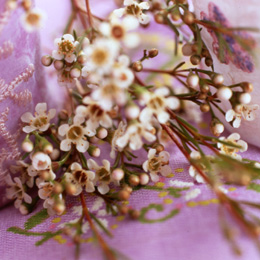 |
<
Waxflower
Botanically named Chamelaucium, waxflower
is related to the eucalyptus. Both are native to Australia;
indeed Chamelaucium is often called Geraldton wax after the
town in Western Australia where it originates. Delicate rounded
cup-shaped flowers occur in sprays along woody stems. The
leaves are long and narrow like pine needles; and have a lovely
scent of lemons mixed with almond when crushed.
>
click here for more info on waxflower
|
|
Gerbera
>
First
imported to Europe from South Africa in the 19th century.
Few people then would have suspected gerbera would become
so popular, with over 200 varieties, in almost every colour
but blue, green and purple. Breeders have also developed new
forms of gerbera, as well as colours; with petals that look
ragged and shredded - as seen in Fresh Folklore - to frilled
double flowers and extra wide petals. A new development is
the mini-gerbera, or "germini"; ideal for smaller
flower arrangements. They have the same bright colours, but
are easier to handle in bouquets.
> click here for
more info on Gerbera
|
|
|
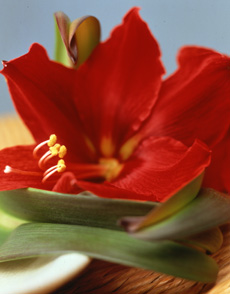
|
<Amaryllis
Flamboyant
starry trumpets on thick smooth stems springing from huge
papery bulbs. Up to four or five dramatic outsize lily-like
flowers appear in white, red, pink, peach or combinations
of these - making an impressive display or stunning bouquet
- especially for Valentine's Day! Amaryllis (amma RILL iss)
are sometimes known as Hippeastrum (hippie AST rum), which
is the botanical name of the family of flowers to which certain
species of amaryllis belong. The flowers are native to South
America, but are grown commercially in Netherlands and UK.
Buy them when still in part-bud if possible - this make them
easier to transport as the flowers are large and can be easily
bruised.
> click here for
more info on Amaryllis
|

back |
|

